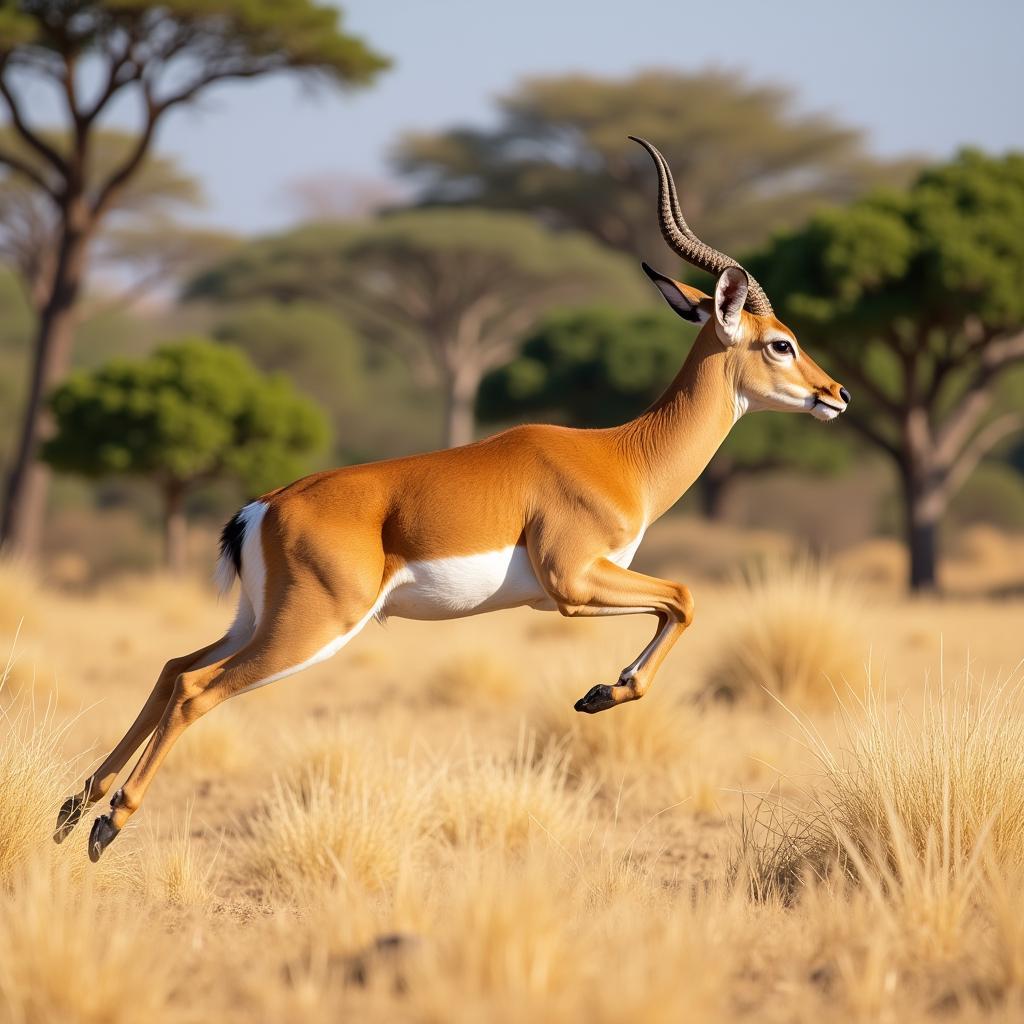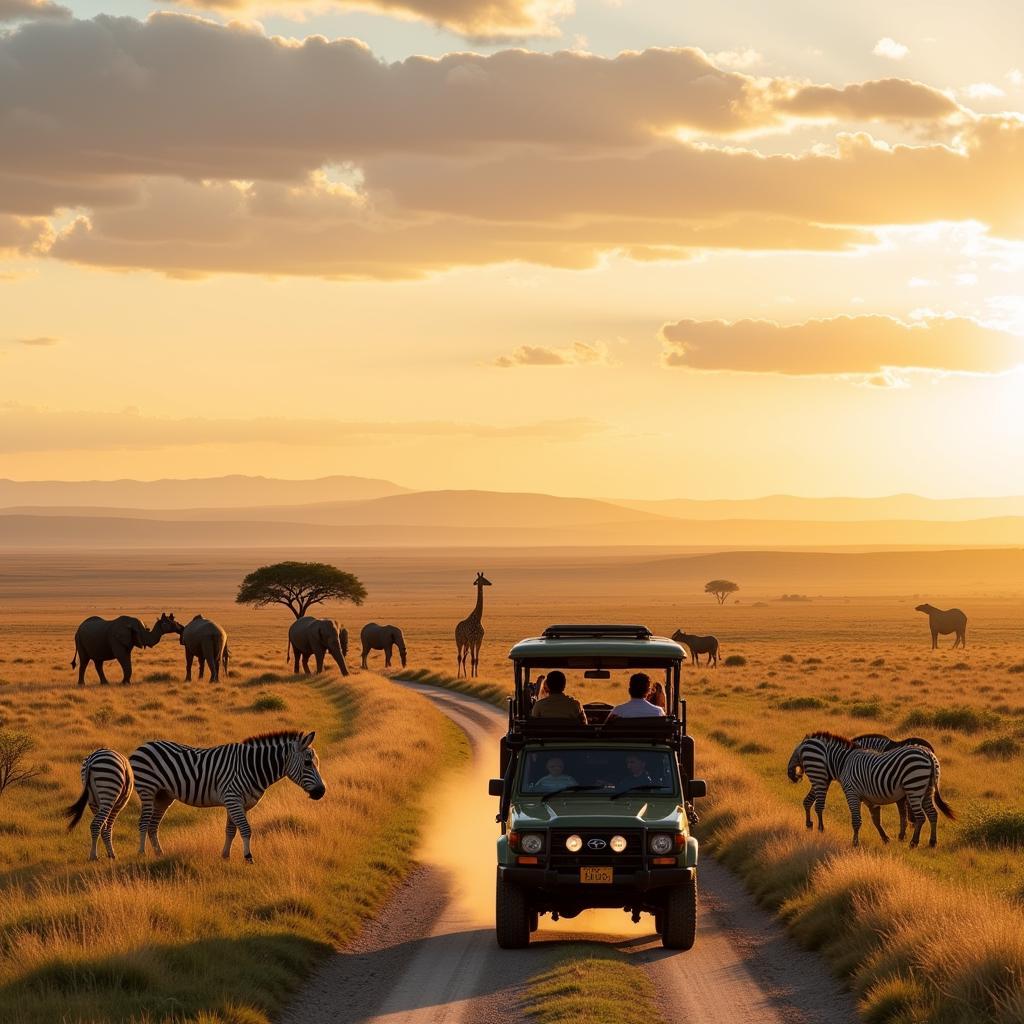The African Impala: A Graceful Icon of the Savannah
The African Impala, a medium-sized antelope, is a common sight across the savannas and woodlands of eastern and southern Africa. Its elegant leaps and distinctive markings make it a truly iconic symbol of the African wilderness. From its social dynamics to its remarkable adaptations, the impala offers a fascinating glimpse into the intricate web of life on the African continent.  African impala leaping across the savanna
African impala leaping across the savanna
Understanding the African Impala: More Than Just a Pretty Face
The African impala is much more than just a beautiful creature; it plays a vital role in the ecosystem. As a herbivore, it grazes on grasses, leaves, and fruits, helping to shape the vegetation of its habitat. The impala, in turn, serves as prey for larger predators like lions, leopards, and cheetahs, contributing to the delicate balance of the food chain.
Impalas are highly social animals, living in herds that can range from a few dozen to several hundred individuals. These herds offer protection from predators and provide opportunities for social interaction. Within the herd, there is a complex social hierarchy, with dominant males leading and defending their territory.
The impala’s incredible agility and leaping ability are essential for survival. They can jump up to 10 feet high and 30 feet long, allowing them to escape predators and navigate challenging terrain. This remarkable athleticism is a testament to the impala’s evolutionary adaptations.
What Makes the African Impala Unique?
Several features distinguish the African impala from other antelope species. The most prominent is its sleek, reddish-brown coat, marked by a distinctive black stripe down its back and a white patch on its rump. Males also possess impressive, lyre-shaped horns, which they use to compete for dominance and defend their territory.
Another unique characteristic is the impala’s specialized scent glands located on its hind legs. These glands secrete a scent that helps individuals recognize each other and maintain social cohesion within the herd.
The Impala’s Role in the African Ecosystem
Dr. Anika Mosi, a renowned wildlife biologist specializing in African ungulates, states: “The impala is a keystone species in many African ecosystems. Its grazing habits influence plant diversity, and its presence as prey supports populations of apex predators.” This highlights the crucial role the impala plays in the intricate web of life on the African savanna.
Threats and Conservation Efforts for the African Impala
While the impala is currently classified as a species of Least Concern by the International Union for Conservation of Nature (IUCN), it faces several threats, including habitat loss due to human encroachment and increasing competition with livestock for grazing resources.
Conservation efforts are crucial to ensure the long-term survival of this iconic species. These efforts include protecting and managing its habitat, monitoring populations, and mitigating human-wildlife conflict. [african impala jets] offer a unique perspective on the vastness of their habitat.
How to Identify an African Impala?
The distinctive markings and behavior of the African impala make it relatively easy to identify. Look for the reddish-brown coat, black stripe, white rump patch, and lyre-shaped horns (in males). Observe its graceful leaps and social behavior within the herd. [african antelope impala] helps distinguish it from other antelope species.
“Understanding the interconnectedness of species like the impala within the larger ecosystem is crucial for effective conservation strategies,” explains Dr. Kamau Njoroge, a conservationist with over 20 years of experience in East Africa.
The Future of the African Impala
The future of the African impala depends on continued conservation efforts and sustainable land management practices. By raising awareness about the importance of this iconic species and its role in the ecosystem, we can work towards ensuring its survival for generations to come. You can learn more about other related species, such as [african deer impala].
In conclusion, the African impala is more than just a beautiful animal; it is a vital component of the African savanna. Its unique adaptations, social dynamics, and ecological importance make it a truly fascinating species. By understanding and appreciating the African impala, we can contribute to its conservation and the preservation of the rich biodiversity of Africa. Learn about other [african antelope beginning with i] here. Proper care for plants like [african desert rose care] helps maintain the ecosystem for animals like the impala.
FAQ
- What is the lifespan of an African impala? Impalas typically live for 10-15 years in the wild.
- What do impalas eat? Impalas are herbivores, consuming grasses, leaves, and fruits.
- Where do impalas live? Impalas are found in the savannas and woodlands of eastern and southern Africa.
- How do impalas defend themselves? Impalas rely on their speed, agility, and leaping ability to escape predators.
- What is the social structure of impala herds? Impala herds have a complex social hierarchy with dominant males leading and defending their territory.
- What are the main threats to impalas? Habitat loss and competition with livestock are the main threats.
- How can I support impala conservation? Supporting organizations working to protect African wildlife and their habitats is a great way to help.
Common Impala Scenarios
- Impala escaping a predator: Imagine a lioness stalking a herd of impalas. Suddenly, the impalas burst into action, leaping and bounding across the savanna to escape the predator’s grasp.
- Impala herd grazing peacefully: Picture a herd of impalas calmly grazing in the afternoon sun, their reddish-brown coats blending with the golden grasses of the savanna.
- Male impalas sparring for dominance: Envision two male impalas locking horns, their powerful bodies pushing against each other as they compete for dominance within the herd.
Related Articles and Questions
You might also be interested in learning about other African antelope species or exploring the broader topic of African wildlife conservation. What other animals share the impala’s habitat? How does climate change impact the impala’s survival?
When you need assistance, please contact us at Phone Number: +255768904061, Email: kaka.mag@gmail.com or visit our address: Mbarali DC Mawindi, Kangaga, Tanzania. We have a 24/7 customer service team.



